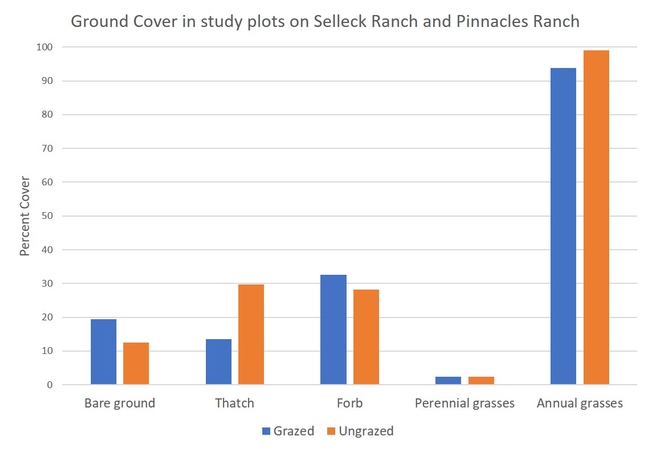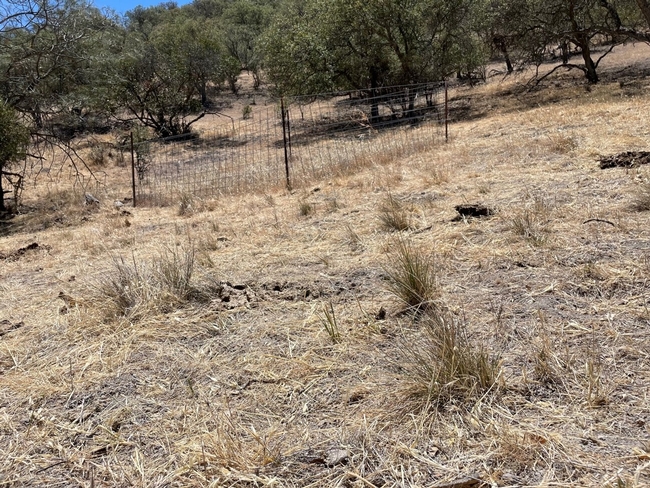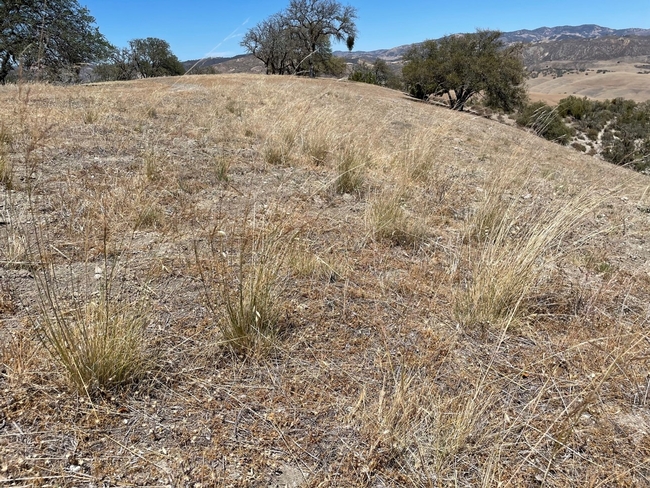This article is a follow-up to Testing Targeted Rotational Grazing for Ecological and Financial Benefits, which was published on this blog on July 7, 2021.
For those of you who have not yet read that article, Liz Reikowski co-owner of Willow Creek Land and Cattle, is a local rancher who received a USDA Western SARE grant to test a couple questions about targeted rotational grazing: 1) Can targeted rotational grazing improve ecological health? and 2) Is targeted rotational grazing a business practice that is practical and profitable for ranchers? In addition to being a rancher, Liz holds a master's degree in Natural Resources Management from the University of Nevada, Reno. So, she is able to use her diversity of skills to get at the answers to her questions. Specific ecological health objectives of the grant are to use targeted rotational grazing to
- Increase cover and density of native perennial grasses
- Increase cover of native forbs (wildflowers)
- Reduce cover of two weeds: tocolote (Centaurea melitensis) and black mustard (Brassica nigra)
This article focuses on preliminary results from data collected in Spring 2022. Liz collected data on two ranches in 2022: Selleck Ranch and Pinnacles Ranch, both in south San Benito County. Each ranch has paired grazed and ungrazed plots: six at Selleck Ranch and four at Pinnacles Ranch. Liz has collected data over three years at these two ranches: 2020, 2021, and 2022. Data were collected between May 20 and June 1 in 2020; between May 8 and May 22 in 2021; and May 20 and 21 in 2022. In 2022, 20 cow/calf pairs grazed on each ranch. At Pinnacles Ranch they grazed from mid-January through early-March and again July 16 through August 19. At Selleck Ranch they grazed early-March through mid-May.
Liz is interested in how grazing influences percent cover of bare ground, thatch (herbaceous vegetation that is at least one year old), forbs (herbaceous plants that are not grasses, forbs are often what we think of as wildflowers), perennial grasses, and annual grasses. Note that the graphs presented in this article do not have standard error bars, so should be interpreted cautiously. Liz will conduct a more detailed analysis after collecting the final year of data in spring 2023.
Figure 1 shows that percent cover of bare ground and forbs was higher in grazed plots. The presence of red stemmed filaree accounted for the higher cover of forbs. In fact, grazed plots had 50% more cover of red stemmed filaree than ungrazed plots. In 2022, Liz collected data on May 20 and 21, which is a bit late for this area, so identifying forbs was difficult. At that time forbs had already dried out. Liz tries to monitor a little later than typical so she can detect some of the summer annuals (e.g., doveweed and vinegar weed) and more easily identify later-blooming grasses such as purple needlegrass. Though, she hopes to collect data earlier next year to get a more accurate assessment of the forb cover. Percent cover of thatch and annual grasses was higher in ungrazed plots. And percent cover of perennial grasses (purple needlegrass and Sandberg bluegrass) was the same in both grazed and ungrazed plots.
Figure 1. Percent cover of bare ground, thatch, forbs, perennial grasses, and annual grasses in grazed and ungrazed plots.
Although percent cover of perennial grasses was not higher in grazed plots, so does not appear to be aided by grazing, it appears that grazing is compatible with perennial grasses, since the cover is not lower in those grazed plots. Figure 2 shows clumps of perennial bunch grasses in the foreground in a grazed plot. Liz has observed that cattle prefer to eat annual grasses during the growing season, reducing competition for perennial grasses and allowing them to continue growing and go to seed. Figure 3 shows robust purple needlegrass plants on a grazed site at Selleck Ranch. This is one of the objectives Liz is trying to achieve with grazing. She says that grazing in winter is a good approach to support purple needlegrass. On the other hand, when grazing in the early summer when annual grasses are dry and purple needlegrass is still green, cattle will prefer to eat the purple needlegrass plants and will eat them down to the crown.
Figure 2. Native perennial bunch grasses in the foreground in a grazed plot, with an ungrazed plot in the background. Photo by Liz Reikowski.
Figure 3. Purple needlegrass bunches in a grazed plot at Selleck Ranch. Photo by Liz Reikowski.
Liz is is also looking at the influence of grazing on a variety of non-native annual grass species, some of which are good forage while others are not desirable to cattle. Figure 4 shows percent cover of wild oats, soft chess, red brome, rattail fescue, and foxtail barley. Wild oats and soft chess are good forage species and had similar cover in both grazed and ungrazed plots. However, two of the undesirable species, ripgut brome and red brome, had higher cover in ungrazed plots. These data suggest that grazing may help reduce undesirable species like ripgut brome, because grazing reduces thatch and some of these undesirable annual grasses do well in higher thatch conditions.
Figure 4. Percent cover of individual annual grass species.
More results and important takeaways
- At Pinnacles Ranch, there was only one plot that had native forbs this year. This was not true in previous years. In 2019 and 2020 there were a lot of native forbs. However, 2021 was a dry year and percent cover of native forbs started declining at that time.
- At Selleck Ranch there were more native plants in the ungrazed plots compared to the grazed plots. But, identifying plants was a challenge this year due to the late timing of data collection. She may observe more cover of native forbs in all plots if she is able to collect data earlier in the season next year.
- At both ranches, Liz did not see much of a difference in the weed tocolote (Centaurea meletensis) in grazed versus ungrazed plots.
- Grasses
- Three native grasses are commonly found on both ranches: pine bluegrass (Poa secunda), purple needlegrass (Stipa pulchra), and melic grasses (Melica sp.). However, there were almost no native grasses observed in her plots this year. Native grass cover was very similar in grazed and ungrazed plots this year.
- Liz detected quite a bit of soft chess (Bromus hordeaceus) this year.
Deciding when it's time to move the cattle
- Liz is not the only person who is making decisions about grazing and when to move the cattle, in order to achieve the results she is looking for. She has a team people who she has trained.
- Liz looks for a couple things when deciding when to move the cattle: 1) minimal bare ground and 2) even utilization, meaning that the cattle have gone everywhere, but damaged nowhere.
- Liz said that training other people to make these decisions is pretty easy. First, they all look at a variety of pastures together at different times of year: sites with steep slopes, sites with no slopes, during the time of year when cows are dry, and when the cows are eating more because they have babies on them. They then talk about what they see and decide together when to move the cattle. She also sometimes uses pictures to help her team understand what she's looking for in the pasture. Having a team of people available to make management decisions is valuable because Liz grazes on multiple properties and is not always available to be at these sites when it's time to move cattle.
- Liz's team, including how they are related to her are
- Matt Reikowski - brother and co-owner of Willow Creek Land and Cattle. Matt knows more about cattle and Liz knows more about plants/rangeland ecology, so they make a good team!
- Pete Reikowki –brother
- Blake Duncan –boyfriend
- David Reikowski and Patty Swanson –parents
- Tina Swanson –aunt
- Audra Devoto, Clark Devoto, and Frank Johnson - friends
- Celeste Card - Matt's girlfriend
- Lauren Brigham - Pete's girlfriend
- Liz also wanted to make sure to include and acknowledge her grandmother, Susan Swanson, who was the original owner of the family's ranch and passed away in 2020. Susan was an important inspiration for Willow Creek Land and Cattle.
Author - San Benito County Director and Area Livestock and Natural Resources Advisor



